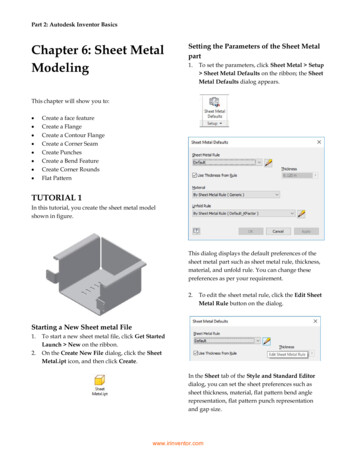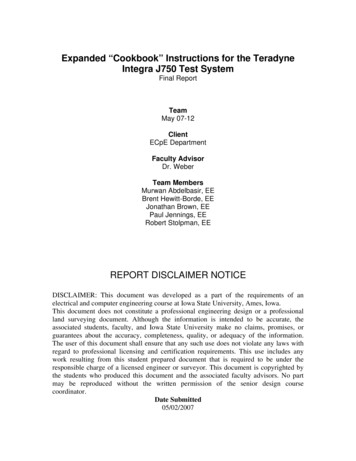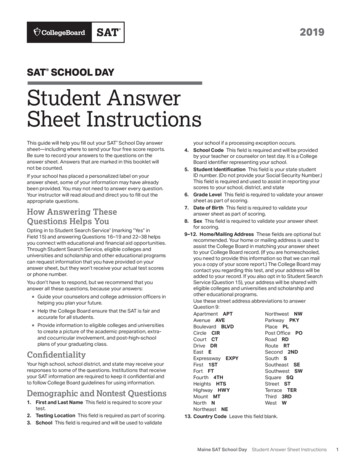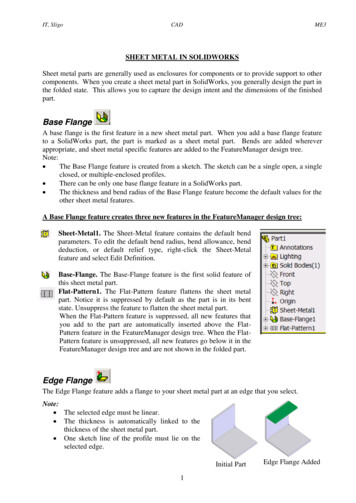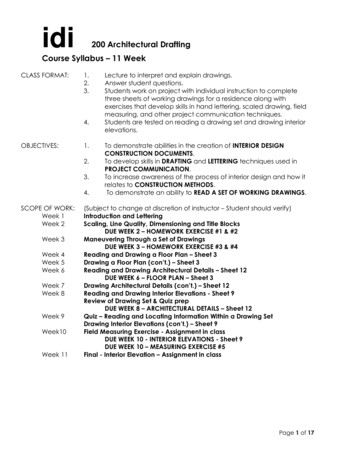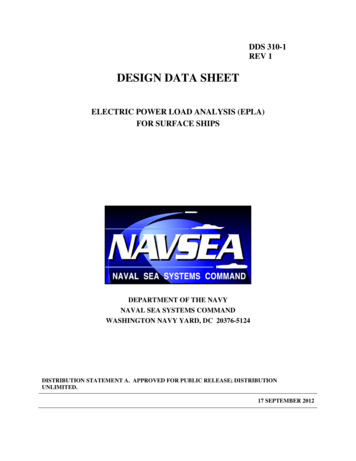
Transcription
DDS 310-1REV 1DESIGN DATA SHEETELECTRIC POWER LOAD ANALYSIS (EPLA)FOR SURFACE SHIPSDEPARTMENT OF THE NAVYNAVAL SEA SYSTEMS COMMANDWASHINGTON NAVY YARD, DC 20376-5124DISTRIBUTION STATEMENT A. APPROVED FOR PUBLIC RELEASE; DISTRIBUTIONUNLIMITED.17 SEPTEMBER 2012
DDS 310-1 REV 1DDS 310-1 REV 117 September 2012Supersedes DDS 310-1 dated 01 July 1980CONTENTSPARAGRAPHPAGE1. APPLICABLE DOCUMENTS1.1 General1.2 Government documents1.2.1 Specifications, standards, and handbooks1.2.2 Other Government documents, drawings, and publications1.3 Non-Government publications1.4 Order of precedence2. INTRODUCTION2.1 Scope3. DEFINITIONS3.1 24-hour average ship service endurance electric load3.2 24-hour average ship service mission electric load profile3.3 24-hour average ship service sustained electric load3.4 Ambient condition profile3.5 Connected load: Identification plate or rated power of the load (kW)3.6 Demand factor3.7 Demand power3.8 Electric and propulsion plant concept of operations3.9 Emergency ship control3.10 Energy storage module3.11 Load factor3.12 Long-term interrupt load3.13 Margin3.14 Maximum residual zonal power demand3.15 Mutually exclusive loads3.16 Operating load3.17 Peak load3.18 Product model3.19 Quality of service (QOS)3.20 Reserve power3.21 Residual zonal power demand3.22 Service interruption3.22.1 Reconfiguration time (t1)3.22.2 Generator start time (t2)3.23 Service life allowance3.24 Ship demand power3.25 Ship operating conditions3.25.1 Anchor3.25.2 Shore3.25.3 Cruising3.25.4 6ii
DDS 310-1 REV 1PARAGRAPHPAGE3.25.5 Emergency3.25.5.1 Surface combatant3.25.5.2 Aircraft carrier3.25.5.3 Amphibious3.25.5.4 Auxiliary3.25.5.5 Mine warfare and patrol craft3.26 Short-term interrupt load3.27 Standby power3.28 Total operating load3.29 Un-interruptible load3.30 Zonal load factor3.31 Zonal operating load3.32 Zonal power system element4. GENERAL REQUIREMENTS4.1 Electric load list4.1.1 Inputs4.1.2 Outputs4.2 24-hour average load parametric equation4.2.1 Inputs4.2.2 Outputs4.3 Load factor analysis4.3.1 Inputs4.3.2 Outputs4.4 Zonal load factor analysis4.4.1 Inputs4.4.2 Outputs4.5 Demand factor analysis4.5.1 Inputs4.5.2 Outputs4.6 Stochastic load analysis4.6.1 Inputs4.6.2 Outputs4.7 Modeling and simulation load analysis4.7.1 Inputs4.7.2 Outputs4.8 Quality of service (QOS) load analysis4.8.1 Inputs4.8.2 Outputs4.9 Comparing trials data with load analysis4.9.1 Inputs4.9.2 Outputs5. SPECIFIC REQUIREMENTS5.1 Electric load list5.1.1 Collecting load data5.1.2 Combining loads5.2 24-hour average load parametric 1111111111111111212iii
DDS 310-1 REV 1PARAGRAPHPAGE5.3 Load factor analysis5.3.1 Assigning load factors5.3.1.1 Load factor assignment considerations5.3.1.2 Load analysis when load data exists5.3.2 Special loads5.3.3 24-hour average load calculations5.3.4 Load factor analysis reports5.3.4.1 EPLA detailed report5.3.4.2 EPLA summary report5.4 Zonal load factor analysis5.4.1 Assigning zonal load factors5.4.2 Zonal load factor analysis reports5.5 Demand factor analysis5.6 Stochastic load analysis5.6.1 Stochastic load analysis guidance5.6.1.1 Introduction5.6.1.2 Load characterization5.6.1.3 Monte Carlo Simulation5.6.1.4 Random variable generation5.6.1.5 Estimating output PDF properties5.6.2 Stochastic load analysis reports5.7 Modeling and simulation load analysis5.7.1 Modeling and simulation load analysis guidance5.7.2 Modeling and simulation load analysis reports5.8 Quality of service (QOS) load analysis5.9 Comparing trials data with load 2525252627FIGURESFigure 1. Inter-relationship of DDS 310-1 tasksFigure 2. Load factor exampleFigure 3. Zonal load factorFigure 4. Demand factor curve (MS 18299)Figure 5. Demand factor curve based on connected loadFigure 6. Uniform distribution PDF and CDFFigure 7. Triangular distribution PDF and CDFFigure 8. Discrete distribution PDF and CDFFigure 9. Normal distribution PDF and CDFFigure 10. Monte Carlo Simulation AlgorithmFigure 11. Inverse transform techniqueFigure C-1. Collection Hold and Transfer (CHT) sewage systemFigure C-2. Electric load time historyFigure C-3. Histogram of CHT power usageFigure C-4. PDF of histogram for CHT power usageFigure C-5. Triangle distribution approximationFigure C-6. Comparison of histogram and triangle -4iv
DDS 310-1 REV 1APPENDICESAPPENDIX A – Load Factor Tables for Surface ShipsAPPENDIX B – Load AmalgamationAPPENDIX C – Stochastic Modeling ExamplePAGEA-1B-1C-1v
DDS 310-1 REV 11. APPLICABLE DOCUMENTS1.1 General. The documents listed in this section are specified in the main body of this document. Thissection does not include documents cited in the Appendices.1.2 Government documents.1.2.1 Specifications, standards, and handbooks. The following specifications, standards, and handbooks formpart of this document to the extent specified herein. Unless otherwise specified, the issues of these documents arethose cited in the solicitation or contract.DEPARTMENT OF DEFENSE STANDARDSMIL-STD-1399-300-Interface Standard for Shipboard Systems, Section 300B, ElectricPower, Alternating CurrentMILITARY STANDARD (MS) DRAWINGSMS 18299-Shipboard Power Demand Factors 450 Volts(Copies of these documents are available online at https://assist.dla.mil or http://assistdocs.com.)1.2.2 Other Government documents, drawings, and publications. The following other Government documents,drawings, and publications form a part of this document to the extent specified herein. Unless otherwise specified,the issues of these documents are those cited in the solicitation or contract.NAVAL SEA SYSTEMS COMMAND (NAVSEA) PUBLICATIONSS9040-AA-IDX-010/SWBS 5D-Expanded Ship Work Breakdown Structure for All Shipsand Ship/Combat Systems (ESWBS)T9300-AF-PRO-020-NAVSEA Design Practice and Criteria Manual, ElectricalSystems for Surface Ships, Chapter 300(Copies of these documents are available from the Naval Logistics Library, 5450 Carlisle Pike, Mechanicsburg, PA17055 or online at https://nll1.ahf.nmci.navy.mil.)NAVAL SEA SYSTEMS COMMAND (NAVSEA) DESIGN DATA SHEETS (DDS)DDS 200-1-Calculation Of Surface Ship Endurance Fuel Requirements(Copies of this document are available from Commander, Naval Sea Systems Command, ATTN: SEA 05S, 1333Isaac Hull Avenue, SE, Stop 5160, Washington Navy Yard DC 20376-5160, or by email atcommandstandards@navy.mil with the subject line “DDS request”.)1.3 Non-Government publications. The following documents form a part of this document to the extentspecified herein. Unless otherwise specified, the issues of these documents are those cited in the solicitation orcontract.CODE OF FEDERAL REGULATIONS (CFR)TITLE 46, PART 112-Shipping: Emergency Lighting And Power Systems(Copies of this document are available from the Superintendent of Documents, U.S. Government Printing Office,Washington, DC 20401 or online at http://www.gpo.gov/fdsys/.)1.4 Order of precedence. Unless otherwise noted herein or in the contract, in the event of a conflict betweenthe text of this document and the references cited herein, the text of this document takes precedence. Nothing in thisdocument, however, supersedes applicable laws and regulations unless a specific exemption has been obtained.1
DDS 310-1 REV 12. INTRODUCTION2.1 Scope. This design data sheet (DDS) provides procedures for preparing an Electric Power Load Analysis(EPLA) for conventional-powered fossil fueled surface ships. However, this DDS may be used as a basis forpreparing a load and power analysis for a ship powered by other means.The EPLA, also referred to as the Electric Plant Load Analysis or the System Load and Power Analysis, is usedas an input for determining the power requirements for electrical generation, energy storage, and power conversioncomponents and equipment and current requirements for electrical distribution equipment and components. TheEPLA is also used to develop 24-hour average electrical load estimates for calculating fuel endurance and annualfuel consumption. The process of creating an EPLA is generally composed of two steps: First, identifying,compiling, estimating, and categorizing all of the electrical loads on a ship; and second, using an algorithm tocombine the estimated loads to determine the design requirements for electrical system components and equipment.Historically, the algorithm used to combine loads to determine the rating of generation has been based on loadfactors, while the algorithm used to combine loads for 450 volt bus feeders to load centers has been based ondemand factors as prescribed in MS 18299. Previously, there has not been a standardized method for combiningloads to size medium voltage to low voltage transformers, energy storage modules, or power conversion equipmentfor zonal architectures.The EPLA provides an estimate of the load that a power system component must serve or an estimate of theaverage load. Different load amalgamation methods will result in different load estimates. Power system designmethods should result in ratings selected for equipment that are likely neither excessively high, nor too low. Toohigh of a rating typically results in higher costs and higher system losses (due to lower system efficiencies whenequipment is lightly loaded) and higher maintenance costs due to lightly loading of prime movers (such as diesels).Too low of a rating can result in higher maintenance costs, expensive post-delivery fixes to the power system, andshedding of loads under normal operation.This DDS provides guidance for modeling and estimating loads, provides five methods for combining loads,provides a method for conducting Quality of Service (QOS) load analysis, and provides a method to compare actualmeasured trials electrical load data with the load analysis.This DDS does not provide specific direction for determining the number or rating of power system equipment.It also does not provide guidance for developing the electric and propulsion plant concept of operation or forensuring adequate fault current for fault detection and isolation. Electrical system design practices and criteria, suchas design considerations to avoid lightly loading generators, are detailed in T9300-AF-PRO-020.This DDS is organized in a task oriented approach. Each method is described as a task and has a dedicatedsubsection of the General Requirements and Specific Requirements sections. Each subsection of the GeneralRequirements section details the inputs and outputs of the applicable methods and is intended to assist the shipdesign management team in planning for the conduct of an EPLA. Each subsection of the Specific Requirementssection provides details on the method to calculate the task outputs based on the inputs. The intended audience ofthe Specific Requirements subsections is the engineer assigned to accomplish the task.The inter-relationship of the tasks described in this document is depicted in figure 1. In particular, note that theEPLA supports a number of ship design activities to include generator selection, energy storage selection, powerconversion selection, feeder cable sizing, endurance fuel calculations, and annual fuel calculations. In many casesthe data that must be generated and captured in the EPLA will be somewhat different for the different ship designactivities. In particular, the load factors evaluated for calculating ship demand power will likely differ from the loadfactors for 24-hour average load calculations and could also differ from zonal load factors for the sizing of zonalpower system elements.For a number of cases, this DDS provides the power system engineer several options for calculating electricalload. The particular method to use will generally be specified in a tasking statement/statement of work, or left to thepower system engineer to pick the most appropriate method. In deciding which method to use, the difference in costassociated with conducting the different types of analyses should be compared to the risk associated with errors inthe load estimates.2
DDS 310-1 REV 1This DDS is a significant revision from the previous version. The next revision is anticipated to updateAppendix A to include more modern loads as well as provide guidance for assigning load factors for 24-houraverage computations. A future revision may also include more detailed guidance for zonal load analysis, stochasticload modeling, and dynamic load modeling.Switchboard Selection and SizingEPLAGeneratorSelection4.3 / 5.3Load FactorAnalysis4.1 / 5.1ElectricLoad List4.9 / 5.9ComparingTrials DataEnduranceFuel CalculationsAnnualFuel Calculations4.8 / 5.8Quality of ServiceLoad Analysis4.7 / 5.7Modeling andSimulationLoad Analysis4.4 / 5.4Zonal LoadFactor Analysis4.6 / 5.6StochasticLoad Analysis24 HourAverageLoadsEnergy StorageSelection and SizingPower Converter,Transformer,Power Panel, and LoadCenter Selection and Sizing4.5 / 5.5Demand FactorAnalysis4.2 / 5.224 Hour AverageLoad ParametricEquationFeeder CableSizingFigure 1. Inter-relationship of DDS 310-1 tasks.3. DEFINITIONS3.1 24-hour average ship service endurance electric load. The 24-Hour Average Endurance Ship ServiceElectric Load is the average anticipated ship service electrical load (including margin and service life allowance)expected over a 24-hour period for the ship service operating condition corresponding to a cruise with self defensecapability for non-combatants or Condition III Wartime Cruising for combatants (as defined by the ship’srequirements documents) for each ambient condition specified in the ambient condition profile. Propulsion relatedShip Service Loads are calculated for the Average Endurance Power. Electric propulsion power is not included.The 24-hour average ship service endurance electric load is used for endurance fuel calculations in accordance withDDS 200-1.3.2 24-hour average ship service mission electric load profile. The 24-Hour Average Mission Ship ServiceElectric Load Profile is the curve of the average anticipated ship service electrical load (including margin andservice life allowance) expected over a 24-hour period for the ship service operating condition corresponding to thespecified missions for each ambient condition specified in the ambient condition profile versus the speeds in thespecified ship speed-time profile. Propulsion related Ship Service Loads are calculated for each speed in thespecified ship speed-time profile. Electric propulsion power is not included. The 24-hour average ship servicemission electric load profile is used for endurance fuel calculations in accordance with DDS 200-1.3
DDS 310-1 REV 13.3 24-hour average ship service sustained electric load. The 24-Hour Average Sustained Ship Service ElectricLoad is the average anticipated ship service electrical load (including margin and service life allowance) expectedover a 24-hour period for the ship service operating condition corresponding to a cruise with self defense capabilityfor non-combatants or Condition III Wartime Cruising for combatants (as defined by the ship’s requirementsdocuments) for each ambient condition specified in the ambient condition profile. Propulsion related Ship ServiceLoads are calculated for the Average Sustained Power. (vice Average Endurance Power for the 24-hour averageship service endurance electric load) Electric propulsion power is not included. The 24-hour average ship servicesustained electric load is used for endurance fuel calculations in accordance with DDS 200-1.3.4 Ambient condition profile. The Ambient Condition Profile consists of a number of (dry bulb)temperature/relative humidity ambient conditions and an associated percentage of time the ship is spent operating inthe particular ambient condition. The ambient condition profile is used for endurance fuel calculations as describedin DDS 200-1. Note that the ambient conditions refer to the atmospheric environment external to the ship.Equipment inside the ship generally does not experience these conditions directly. Unless otherwise specified, thefollowing default ambient condition profiles shall be used:a.25% of time at 10 F with 95% relative humidityb.50% of time at 59 F with 95% relative humidityc.25% of time at100 F with 40% relative humidityThe intent of this default profile is to promote fuel efficiency across the expected range of temperatures the shipwill experience. This profile should be modified if a ship is expected to operate in a range of ambient conditionsthat is significantly different.3.5 Connected load: Identification plate or rated power of the load (kW). For equipment with a rated currentinstead of a rated power, the rated current shall be converted to rated power using an appropriate power factor.(Resistive loads usually have a power factor of about 1.0. Induction motor loads typically have a power factorbetween about 0.70 and 0.90 with higher values for larger and more modern motors. The nameplate on an inductionmotor may include the power factor at rated load.)3.6 Demand factor. A factor applied to the connected load of a bus feeder to determine the required rating ofthat bus feeder. The demand factor is used to estimate the load based on historical operations.3.7 Demand power. For a given operating condition and ambient condition, the amount of electrical power aparticular power system component must be capable of supplying continuously.3.8 Electric and propulsion plant concept of operations. Electric and propulsion plant concept of operations isused to determine which prime movers and power conversion equipment are online, and for determining how poweris shared among the prime movers and power conversion equipment for given operational conditions and loads. ForQOS calculations, it also includes reconfiguration time (t1) and generator start time (t2) as well as the minimummission speed to determine the amount of propulsion power to be considered Long-Term Interrupt Load. Theelectric and propulsion plant concept of operations also includes the electric plant configuration or line up ofswitchgear for each operational condition.3.9 Emergency ship control. Emergency ship control requirements are as defined by the customer andT9300-AF-PRO-020. Generally, emergency ship control includes, as a minimum, the following electrical loads:a.Steering gear and associated auxiliaries.b.Vital propulsion and propulsion auxiliaries. Vital propulsion and propulsion auxiliaries are:(1) Required for cold starting the ship’s propulsion plant.(2) Necessary for propulsion machinery protection.(3) Needed to achieve a minimum emergency propulsion capability (typically 7 knots) if propulsioncannot be otherwise restored in less than 2 minutes.c.Machinery space class W and circle W ventilation.d.Emergency lighting.4
DDS 310-1 REV 1e.Emergency communications and radio communication systems.f.Navigation Systems and Navigation Lights.g. Fire pumps, fire containment equipment, magazine sprinkling, dewatering pumps, and associated damagecontrol equipment.h.Control systems, critical sensors, networks, and interior communications supporting emergency systems.i. Auxiliaries to support the emergency generator and all equipment necessary to generate and distributepower to the other emergency loads, Auxiliaries required to directly support other emergency loads.j.Personnel locator.k.Flammable fluid isolation valves.l.Exhaust ventilation for desmoking and damage control ventilation.3.10 Energy storage module. An Energy Storage Module (ESM) stores energy provided by the electricalpower system and uses that energy to provide power back to the electrical power system at a later time. An ESMcan be based on a host of technologies to include batteries, flywheels, and ultra-capacitors. Energy storage can beprovided for use in a specific zone and for use across the entire ship.3.11 Load factor. For a given load, the ratio of the operating load to the connected load.3.12 Long-term interrupt load. Loads that can tolerate service interruptions in excess of t2 are categorized aslong-term interrupt loads. A load can tolerate a service interruption when the functional system the load supportscan still meet its requirement without the load functioning for a period of time as a result of the service interruption.3.13 Margin. A factor applied during design and construction to increase the load estimate to account fordesign and estimation uncertainty (the difference between the actual load at ship delivery and the load estimate atship delivery). In earlier stages of design, margins are typically higher than in later stages of design. Any marginremaining at ship delivery is converted into service life allowance. T9300-AF-PRO-020 provides margin policy.3.14 Maximum residual zonal power demand. For a zonal power system element, ship operating condition,and ambient condition, the maximum residual zonal power demand is the maximum of the residual zonal powerdemands of the loads powered by the zonal power system element.3.15 Mutually exclusive loads. Loads that cannot be on at the same time through either an inter-lock or via anestablished procedure.3.16 Operating load. For a given ambient condition and operating condition, the operating load represents aload’s demand for power (kW). In 24-hour average load calculations, the operating load corresponds to thelong-term average. For ship demand power calculations and zonal demand power calculations, the operating loadmay be somewhat greater than the average value to ensure equipment is sized properly to accommodate variance ofthe load around the average value for extended periods of time. Operating load does not include instantaneouspower surges which are caused by starting large motors or short duration peak loads.3.17 Peak load. The maximum power a load will draw (not considering transients). The peak load should beless than or equal to a load’s connected load.3.18 Product model. A product model is the combination of 3D geometry and non-graphic attributes to defineship objects such as a piece of equipment, deck, bulkhead, etc. A product model can define systems views,behavioral properties, interim products, and ultimately the entire ship.3.19 Quality of service (QOS). Quality of Service (QOS) is a metric of how reliably the power systemprovides power to the loads. It is calculated as a Mean-Time-Between-Service-Interruption (MTBSI). QOS is areliability metric; as such, the calculation of QOS metrics does not take into account survivability events such asbattle damage, collisions, fires, or flooding. QOS does take into account equipment failures and normal systemoperation transients. Loads can be categorized into the following three QOS categories:a.Un-interruptibleb.Short-term interrupt5
DDS 310-1 REV 1c.Long-term interrupt3.20 Reserve power. Within a power system, the difference between the total amount of power generationcapacity (including energy storage with a hold-up time greater than t2) available within time t1 measured in kW andthe ship demand power. Reserve power is composed of the rolling reserve of online generators and the power ratingof energy storage.3.21 Residual zonal power demand. For a load, the difference between its peak load (kW) and zonal operatingload (kW).3.22 Service interruption. A service interruption is any interruption in service, or power quality degradationoutside of acceptable parameters for a period of time, which result in the functional system the load supports notbeing capable of meeting its requirements. The duration of service interruption is measured relative to two systemdependent times: reconfiguration time (t1) and generator start time (t2).3.22.1 Reconfiguration time (t1). Reconfiguration time (t1) is defined as the maximum time to reconfigure thedistribution system (typically an automatic switchgear function) without bringing on additional generation capacity.For systems employing conventional circuit breakers, t1 can be on the order of 1 to 2 seconds (as implied by therecovery time requirements in MIL-STD-1399-300). t1 should be specified in the electric and propulsion plantconcept of operations.3.22.2 Generator start time (t2). Generator start time (t2) is defined as the maximum time to bring the sloweststandby power generation module online. t2 can be on the order of several minutes (see the power interruptionparagraph in MIL-STD-1399-300). Unless otherwise specified in the electric and propulsion plant concept ofoperations, for gas turbine and diesel generator sets, the t2 time shall assume one failed start attempt followed by asuccessful start if the probability of a successful first start is less than 95 percent and shall assume a successful firststart otherwise. The electric and propulsion plant concept of operations shall specify which power generationmodules may serve as a standby power generation module, and the operating state of the standby power generationmodule and associated auxiliaries.3.23 Service life allowance. Extra capacity incorporated into the power system to accommodate future growthin loads due to ship modernization and load deterioration. Service life allowance was formerly known as service lifemargin. T9300-AF-PRO-020 provides service life allowance policy.3.24 Ship demand power. For a given operating condition and ambient condition, the amount of electricalpower the ship’s power system must be capable of supplying continuously. The ship demand power is used to selectand establish the rating of generator sets and possibly energy storage modules. The ship demand power is obtainedby applying margin and service life allowance to the total operating load.3.25 Ship operating conditions.3.25.1 Anchor. An anchor condition is a ship operating condition in which the ship supplies all electric powerwhile the ship is at anchor.3.25.2 Shore. A shore condition is a ship operating condition in which the ship receives all electric power froma shore facility or a tender.3.25.3 Cruising. A cruising condition is a ship operating condition corresponding to:a.Condition III Wartime Cruising as defined by the ship’s requirements documents, for combatants.b. Cruising at a specified cruising speed; has self defense capability (if provided), but is not at generalquarters for non-combatants.3.25.4 Functional. A functional condition is a ship operating condition in which the ship is performing itsdesigned function. The following are examples of a functional condition:a.Battle for destroyers and frigates.b.Air operation for aircraft carriers.c.Debarking operation for cargo and amphibious warfare ships.6
DDS 310-1 REV 1d.Replenishment-at-sea of ships for combat support and store ships.e.Tending operations for tenders and repair ships.3.25.5 Emergency. An emergency condition is a ship operating condition in which the ship is on emergencygenerator with ship service generators down. The emergency generators, as a minimum, supply loads associatedwith the following:3.25.5.1 Surface combatant. Emergency ship control and selected self defense weapons.3.25.5.2 Aircraft carrier. Emergency ship control and the larger electrical load associate with selected weaponsor limited air operations (recovery and strike down of aircraft).3.25.5.3 Amphibious. Emergency ship control and limited unloading operations.3.25.5.4 Auxiliary. As listed in the Code of Federal Regulations, Title 46, Part 112.3.25.5.5 Mine warfare and patrol craft. Emergency ship control.3.26 Short-term interrupt load. Loads that can tolerate service interruptions in excess of t1 but cannot tolerateservice interruptions greater than t2 are categorized as short-term interrupt loads. A load can tolerate a serviceinterruption when the functional system the load supports can still meet its requirement without the load functioningfor a period of time as a result of the service interruption.3.27 Standby power. Within a power system, the amount of power generation capacity (kW) that is notavailable for use within time t1, but can be made available for use within time t2.3.28 Total operating load. For a given operating condition and ambient condition, the total operating load isthe sum of all the operating loads powered by a zonal power system element, or for the total ship. Margin andservice life allowance are not applied to the total operating load.3.29 Un-interruptible load. Loads that cannot tolerate service interruptions in excess of t1 are categorized asun-interruptable loads. A load can tolerate a service interruption when the functional system the load supports canstill meet its requirement without the load functioning for a period of time as a result of the service interruption.3.30 Zonal load factor. The load factor of a load adjusted (if necessary) to account for load variability for thepurpose of determining the required rating of zonal power systems elements.3.31 Zonal operating load. The product of a load’s zonal load factor and connected load.3.32 Zonal power system element. A zonal power system element is one of the following: zonal powerconversion equipment, load center, bus feeders, zonal transformers, or zonal energy storage. Small distributiontransformers are not considered zonal power system elements.4. GENERAL REQUIREMENTS4.1 Electric load list. The first step in performing a load analysis is creating an electric load list of all the loadson a ship. This list is derived from the inputs specified in 4.1.1. Equipment items are categorized according to thethree-digit SWBS and their connected load is estimated and tabulated. As the ship’s electrical plant one linediagram and the general/machinery arrangements are developed, the electric load list also groups the loadsaccording to their connectivity to load centers/switchboards. Details for determining and estimating load areprovided in 5.1.4.1.1 Inputs.1.Master equipment list2.Combat systems description and one line diagram3.Electrical plant description and one lin
DDS 310-1 REV 1 ii DDS 310-1 REV 1 17 September 2012 Supersedes DDS 310-1 dated 01 July 1980 CONTENTS PARAGRAPH PAGE 1. APPLICABLE DOCUMENTS 1 1.1 General 1 1.2 Government documents 1 1.2.1 Specifications, standards, and handbooks 1 1.2.2 Other Government documents, drawings, and publications 1 1.3 Non-Government publications 1
